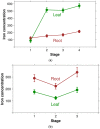A Survey of Plant Iron Content-A Semi-Systematic Review
- PMID: 26690470
- PMCID: PMC4690087
- DOI: 10.3390/nu7125535
A Survey of Plant Iron Content-A Semi-Systematic Review
Abstract
Iron is an essential mineral nutrient for all living organisms, involved in a plurality of biological processes. Its deficit is the cause of the most common form of anemia in the world: iron deficiency anemia (IDA). This paper reviews iron content in various parts of 1228 plant species and its absorption from herbal products, based on data collected from the literature in a semi-systematic manner. Five hundred genera randomly selected from the Angiosperms group, 215 genera from the Pteridophytes groups and all 95 Gymnosperm genera as listed in the Plant List version 1.1 were used as keywords together with the word "iron" in computerized searches. Iron data about additional genera returned by those searches were extracted and included in the analysis. In total, iron content values for a number of 1228 species, 5 subspecies, and 5 varieties were collected. Descriptive and inferential statistics were used to compare iron contents in various plant parts (whole plant, roots, stems, shoots, leaves, aerial parts, flowers, fruits, seeds, wood, bark, other parts) and exploratory analyses by taxonomic groups and life-forms were carried out. The absorption and potential relevance of herbal iron for iron supplementation are discussed.
Keywords: anemia; food supplements; herbal organs; iron; life-forms; taxonomic groups.
Figures






Similar articles
-
[Determination of six mineral elements in roots, stems, leaves, flowers and seeds of Scutellaria baicalensis by FAAS].Guang Pu Xue Yu Guang Pu Fen Xi. 2009 Feb;29(2):519-21. Guang Pu Xue Yu Guang Pu Fen Xi. 2009. PMID: 19445242 Chinese.
-
Gas chromatography-mass spectrometry analysis of essential oils from five parts of Chaihu (Radix Bupleuri Chinensis).J Tradit Chin Med. 2014 Dec;34(6):741-8. doi: 10.1016/s0254-6272(15)30090-x. J Tradit Chin Med. 2014. PMID: 25618980
-
Biological activity of alkaloids from Solanum dulcamara L.Nat Prod Res. 2009;23(8):719-23. doi: 10.1080/14786410802267692. Nat Prod Res. 2009. PMID: 19418354
-
A review on phytochemicals, metabolic profiles and pharmacokinetics studies of the different parts (juice, seeds, peel, flowers, leaves and bark) of pomegranate (Punica granatum L.).Food Chem. 2022 Nov 30;395:133600. doi: 10.1016/j.foodchem.2022.133600. Epub 2022 Jun 30. Food Chem. 2022. PMID: 35793588 Review.
-
Mechanical properties and structure-function trade-offs in secondary xylem of young roots and stems.J Exp Bot. 2019 Jul 23;70(14):3679-3691. doi: 10.1093/jxb/erz286. J Exp Bot. 2019. PMID: 31301134 Review.
Cited by
-
Chemical Composition, Antioxidant and Antimicrobial Activity of Raspberry, Blackberry and Raspberry-Blackberry Hybrid Leaf Buds.Molecules. 2021 Jan 10;26(2):327. doi: 10.3390/molecules26020327. Molecules. 2021. PMID: 33435253 Free PMC article.
-
Unveiling the Behavior of an Endangered Facultative Cuprophyte Coincya Species in an Abandoned Copper Mine (Southeast Portugal).Plants (Basel). 2024 Oct 11;13(20):2847. doi: 10.3390/plants13202847. Plants (Basel). 2024. PMID: 39458794 Free PMC article.
-
Aspergillus Utilizes Extracellular Heme as an Iron Source During Invasive Pneumonia, Driving Infection Severity.J Infect Dis. 2022 May 16;225(10):1811-1821. doi: 10.1093/infdis/jiac079. J Infect Dis. 2022. PMID: 35267014 Free PMC article.
-
More than Just Wine: The Nutritional Benefits of Grapevine Leaves.Foods. 2021 Sep 23;10(10):2251. doi: 10.3390/foods10102251. Foods. 2021. PMID: 34681299 Free PMC article.
-
Relationship between metal and pigment concentrations in the Fe-hyperaccumulator moss Scopelophila ligulata.J Plant Res. 2017 Jan;130(1):135-141. doi: 10.1007/s10265-016-0867-3. Epub 2016 Oct 19. J Plant Res. 2017. PMID: 27761669
References
-
- Rolfes S.R., Pinna K., Whitney E.N. Understanding Normal and Clinical Nutrition. 8th ed. Wadsworth/Cengage Learning; Belmont, CA, USA: 2009. p. 442.
-
- Webb G.P. Dietary Supplements and Functional Foods. Kindle ed. Blackwell Publishing; Chichester, UK: 2011.
-
- Sizer F., Whitney E. Nutrition: Concepts and Controversies. 11th ed. Thomson Higher Education; Belmont, CA, USA: 2008. p. 297.
-
- Khambalia A.Z., Zlotkin S.H. Iron. In: Duggan C., Watkins J.B., Walker W.A., editors. Nutrition in Pediatrics. Basic Science. Clinical Applications. BC Dekker; Hamilton, ON, Canada: 2007. pp. 86–87.
Publication types
MeSH terms
Substances
LinkOut - more resources
Full Text Sources
Other Literature Sources
Molecular Biology Databases

